Get Crackin’
Cured!
It’s finally time to get crackin’. Literally. Black walnuts are ready for shelling.
This nutty story goes back to early this past autumn as black walnut trees were shedding their nuts. The nuts fall in their husks, the whole package looking like green tennis balls. Lots of people curse the trees for littering lawns, sidewalks, and driveways. We, on the other hand, praise and collect the nuts.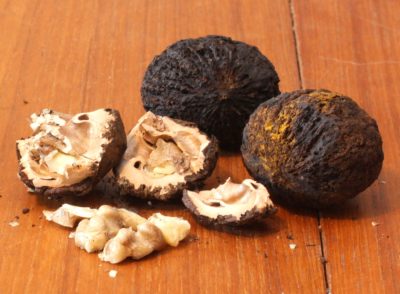
The first step to the present day crackin’ was husking the nuts. The soft, fleshy covering is easy to twist off the enclosed, hard-shelled nut. But we’ve also tried many methods to speed up the process, from spreading the dropped fruit in the driveway and driving over them to pounding them through a 1-1/2” hole in a thick piece of plywood to running them through a suitably modified old-fashioned corn-sheller.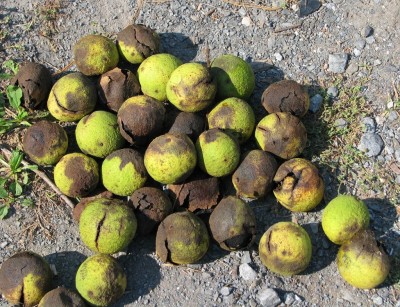
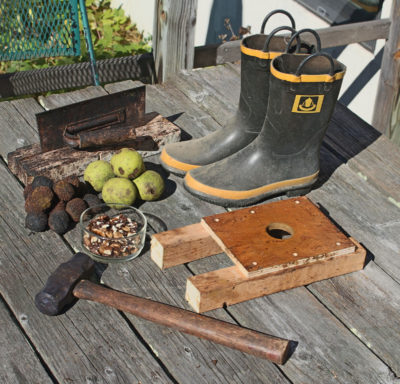
There’s no way around it: Husking black walnuts is a tedious job. And messy, because the soft flesh readily releases a juice which stains everything a deep brown color.
A friend recently told me of some novice black walnut enthusiasts that husked the walnuts bare handed, assuming the stain would wash off when they were finished. Not so. My wife Deb, who husks our black walnuts, chooses to sit herself down on a stool, don rubber gloves, and twist off the hulls, coaxing firm ones off with an initial tap with a light sledge hammer.
(The stain, which is colorfast and resistant to ultraviolet rays, is very easy to extract from the hulls for ink, for dyeing textiles, and staining wood. Just mix the hulls or unhulled nuts with water and boil for awhile or let sit a longer while. Strain and you’re good to go.)
In not too long, we had a number of 5 gallon bucketfuls of hulled nuts — a slimy, ugly mess from bits of hull still attached to the nuts and from the myriad white maggots crawling.
Now it was my turn — to clean up the nuts. I loaded all the nuts into shallow harvest boxes that had plenty of large holes for air or water and drove over to a nearby car wash. After suiting up in an old pair of rain pants, a rain jacket, rubber gloves, and a face shield, and spreading out the boxes on the ground in the car wash, I gave them a thorough, water-only cleaning.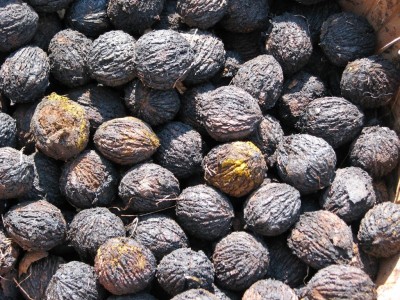
I then spread the boxes out in the sun for a couple of days to dry out the surface of the nuts. Squirrels would be a serious threat but I spread the boxes on our south-facing deck where our two dogs also spend much of the day unknowingly guarding the nuts. Each night, or if any rain was predicted, I stacked and covered the boxes.
After the nuts were sufficiently dry, I stacked the trays in the barn where our cat is the squirrel deterrent.
Then the nuts needed to be cured, which involves nothing more than leaving them alone in a cool, dry, squirrel-fee area. And that brings us up to the present day.
A Tough Nut
Black walnut is a hard nut to crack. No run-of-the-mill nutcracker is up to the job. The usual tool, which is effective, is a hammer against the nut resting on an anvil or concrete. Used with care, a vise might do the job.
Two problems: With the hammer, hitting your finger occasionally as you hold the nut is inevitable. You could, I guess, hold the nut in a pliers. With either method, you have to use just the right amount of force to crack the shell sufficiently in order to extract the nutmeats in reasonable sized pieces without crushing everything too, too small.
The hands-down best job for cracking black walnuts is, in my opinion, the “Master Nut Cracker” (http://www.masternutcracker.com). It’s expensive but well worth the money for the speed with which the nuts can be cracked and the large nutmeats that result from efficient cracking. Besides which, it’s a very well-made tool with a very ingenious design.
Once nuts are cracked, nutmeats still occasionally need further coaxing to free them from the shell. A useful tool that I use that almost everyone has is a type of wire cutter sometimes called a diagonal cutting plier. The right squeeze in the right place, the result of observation and practice, yields large nutmeats that pop right out.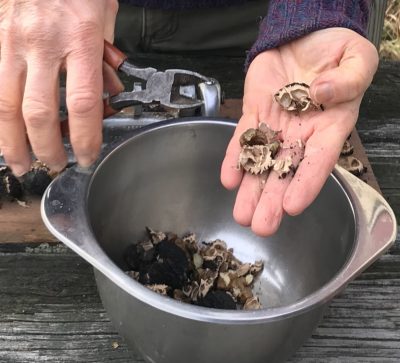
But Is It For You?
Black walnuts have a strong flavor that, like dark beer and okra, is loved by some but not enjoyed by everyone. But there’s no reason why everyone should like everything. Leave that goal to MacDonald’s. As L. H. Bailey, a doyen of horticulture, wrote back in 1922 (about apples), “Why do we need so many kinds of apples? Because there are so many kinds of folks. A person has a right to gratify his legitimate tastes.”
Black walnut is one of my favorite nuts. And, the trees and nuts abound around here, and elsewhere, free for the taking.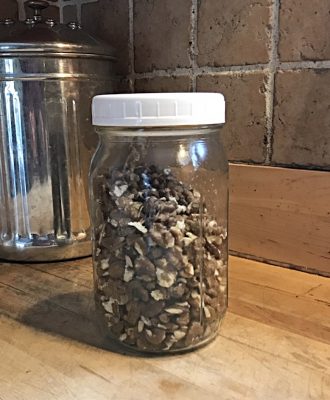
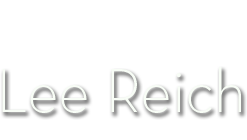
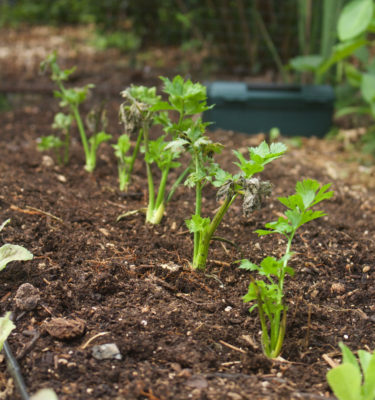
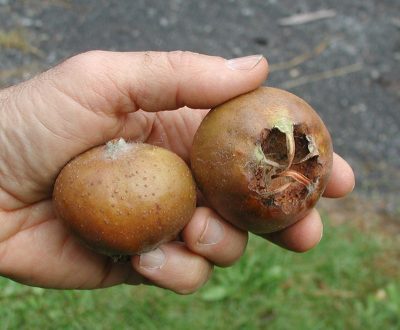 Usually the plant is pest-free but a few years ago something, perhaps a fungus, perhaps an insect, started attacking it, leaving the flesh dry and crumbly. I have yet to identify the culprit so that appropriate action can be taken.
Usually the plant is pest-free but a few years ago something, perhaps a fungus, perhaps an insect, started attacking it, leaving the flesh dry and crumbly. I have yet to identify the culprit so that appropriate action can be taken.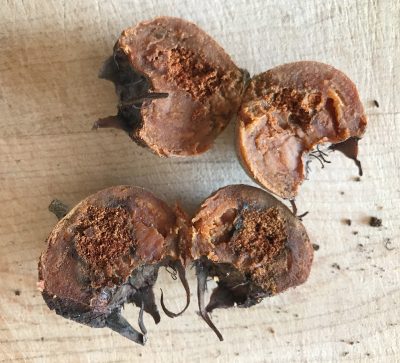
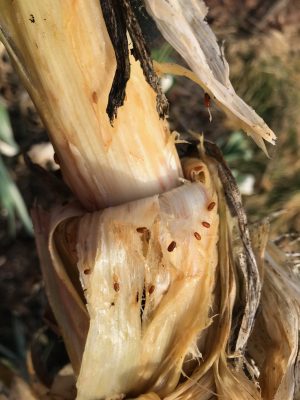
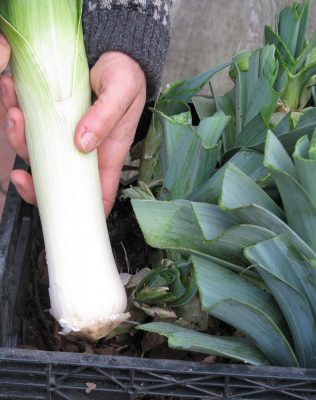
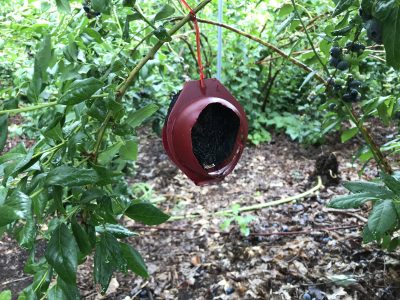
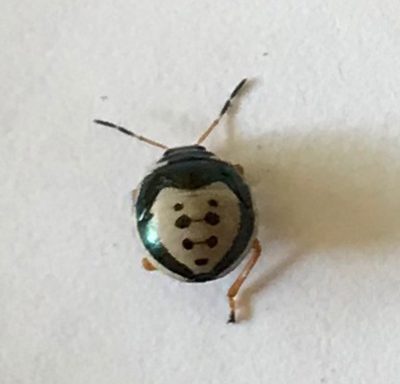
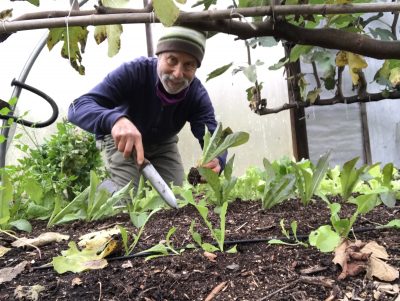
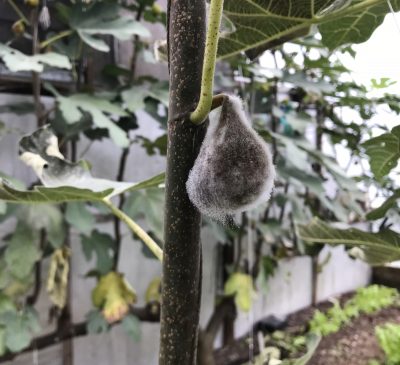
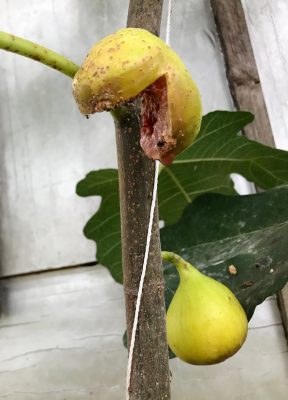 Roots of Rabbi Samuel fig, near the endwall, spread under the wall and outside the greenhouse, soaking up so much water that the figs split before ripening. Yet, a few fig fruits escape both afflictions and ripen to juicy sweetness.
Roots of Rabbi Samuel fig, near the endwall, spread under the wall and outside the greenhouse, soaking up so much water that the figs split before ripening. Yet, a few fig fruits escape both afflictions and ripen to juicy sweetness.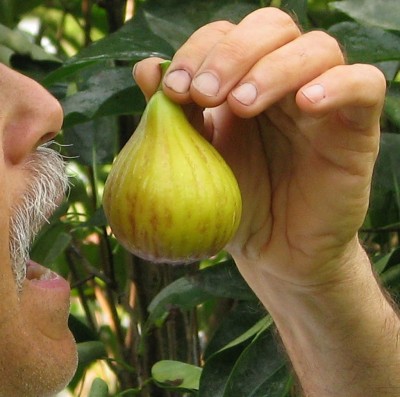
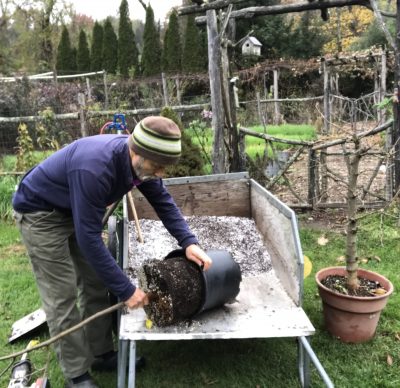 After standing the root ball upright, I started slicing it from top to bottom. For root balls 18 to 24 inches across, I slice a couple inches off all around. I used to use an old kitchen knife but discovered that my reciprocating saw with a medium-tooth blade works much better.
After standing the root ball upright, I started slicing it from top to bottom. For root balls 18 to 24 inches across, I slice a couple inches off all around. I used to use an old kitchen knife but discovered that my reciprocating saw with a medium-tooth blade works much better.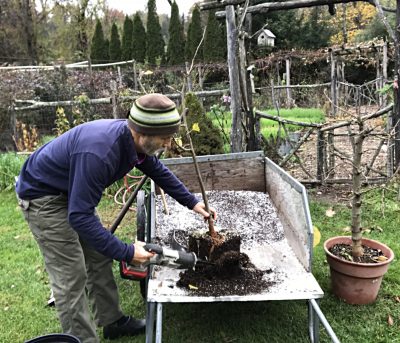
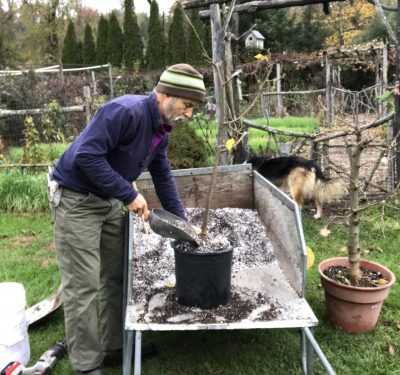 For good contact, I pack the potting soil in with my fingers and the flat end of a 3/4 inch dowel.
For good contact, I pack the potting soil in with my fingers and the flat end of a 3/4 inch dowel.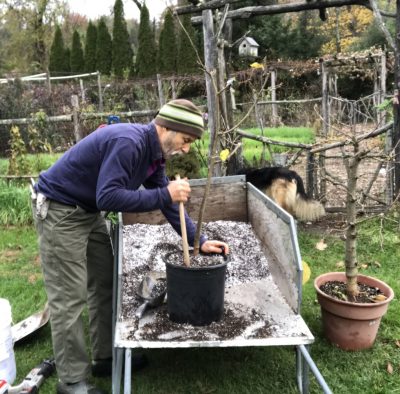
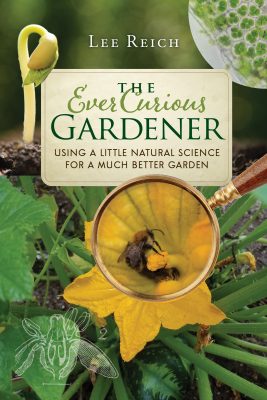
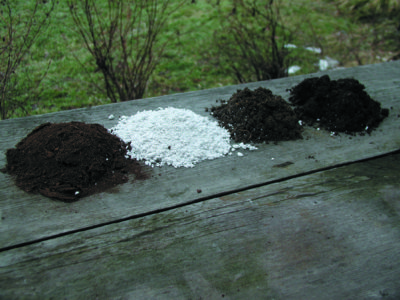
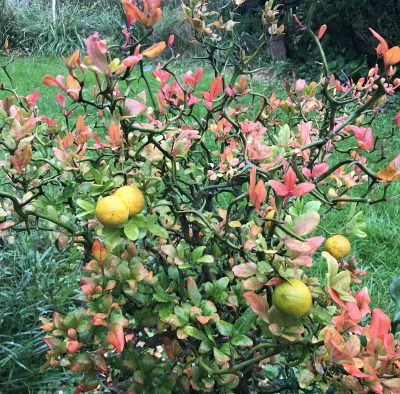
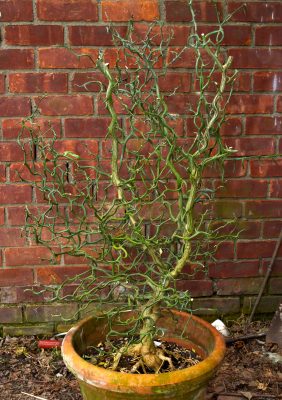
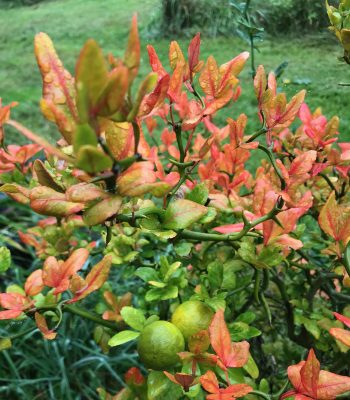
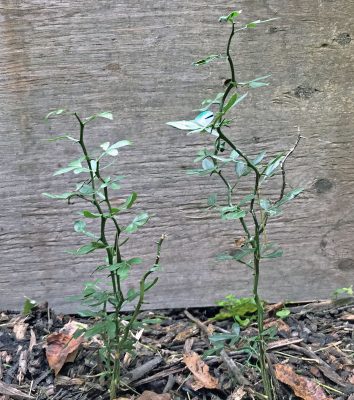
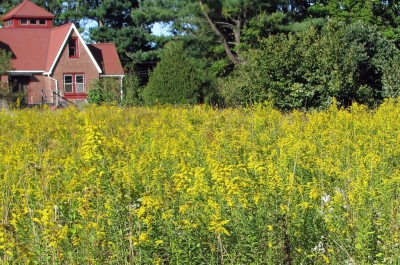 Goldenrod gets the blame for its showy, yellow blossoms during this allergy season. But the true culprit is ragweed, which goes unnoticed because it bears only small, green flowers.
Goldenrod gets the blame for its showy, yellow blossoms during this allergy season. But the true culprit is ragweed, which goes unnoticed because it bears only small, green flowers.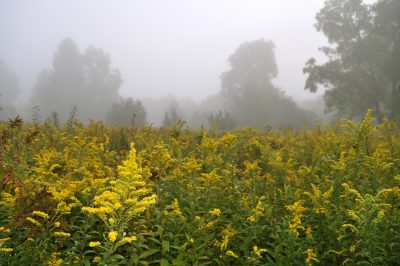
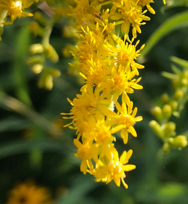
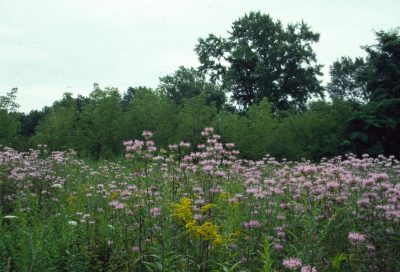
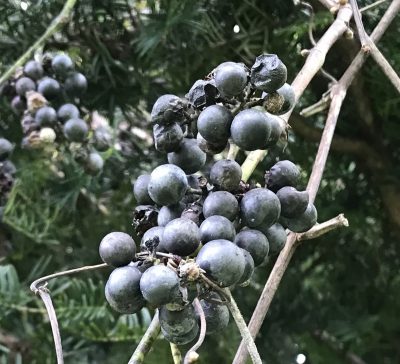
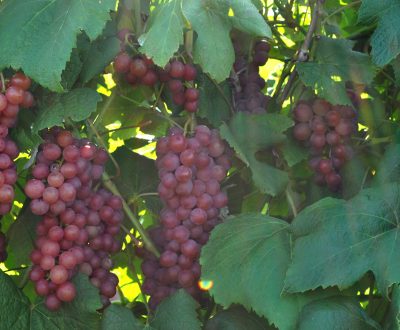
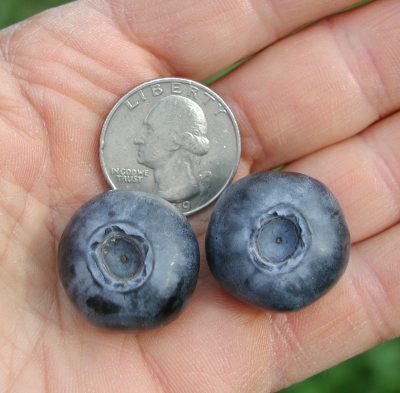
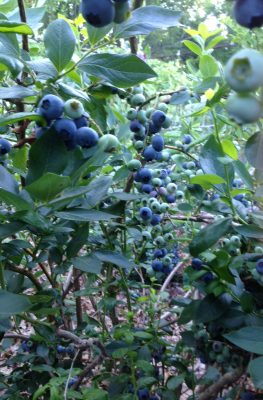 As I write, in September, the variety Elliot is still bearing ripe berries.
As I write, in September, the variety Elliot is still bearing ripe berries.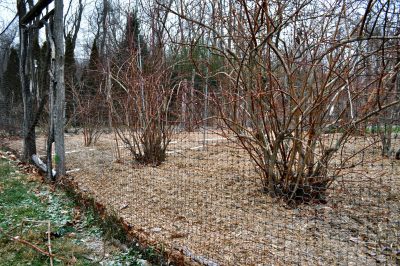
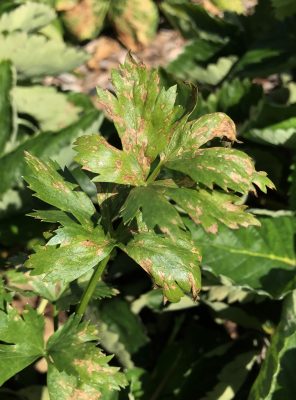 Last fall I thoroughly cleaned up diseased plants, even planted some celeriac this year in the greenhouse. Failure occurred both outdoors and in the greenhouse, although lots of rain and heat could have helped (the fungi or bacteria, not me).
Last fall I thoroughly cleaned up diseased plants, even planted some celeriac this year in the greenhouse. Failure occurred both outdoors and in the greenhouse, although lots of rain and heat could have helped (the fungi or bacteria, not me).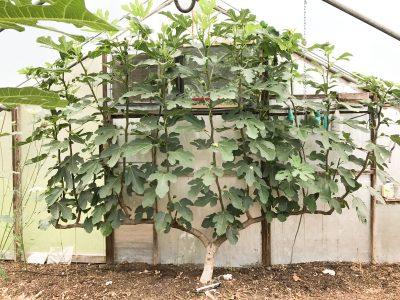 Left to its own devices, a fig can grow into a tangled mess. In part, that’s because fig trees can’t decide if they want to be small trees, with single or a few trunks, or large shrubs, with sprouts and side branches popping out all over the place.
Left to its own devices, a fig can grow into a tangled mess. In part, that’s because fig trees can’t decide if they want to be small trees, with single or a few trunks, or large shrubs, with sprouts and side branches popping out all over the place.
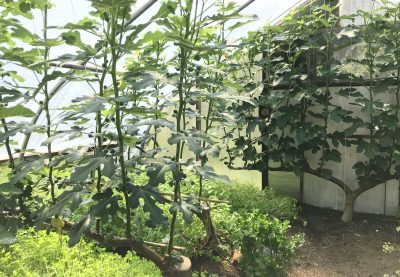 All that despite my attempts at control by going over plants with a toothbrush dipped in alcohol, oil sprays, and sticky barriers to keep ants, which “farm” these pests, from climbing up the trunks.
All that despite my attempts at control by going over plants with a toothbrush dipped in alcohol, oil sprays, and sticky barriers to keep ants, which “farm” these pests, from climbing up the trunks.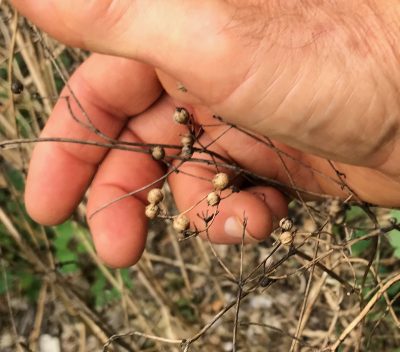 Those seeds will drop and germinate in the cooler temperature a few weeks hence. But I need cilantro now.
Those seeds will drop and germinate in the cooler temperature a few weeks hence. But I need cilantro now.
 So I started the water sprays again, which have the potential problem of creating so much humidity and moisture that ripening figs rot. On the other hand, it might set back the scale, perhaps by knocking off ants, who “farm” scale. I also ordered a new predator, one for scale, Aphytis melinus.
So I started the water sprays again, which have the potential problem of creating so much humidity and moisture that ripening figs rot. On the other hand, it might set back the scale, perhaps by knocking off ants, who “farm” scale. I also ordered a new predator, one for scale, Aphytis melinus.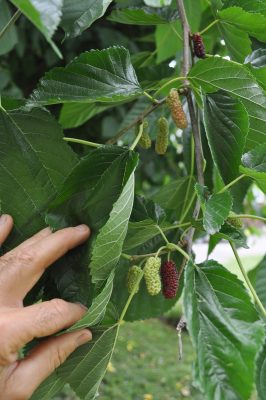 Birds also eat fruit for their juiciness, and the past weeks and weeks of abundant rainfall probably satisfied some of that need. The only other year I had plenty of mulberries — much more than this year — was a few years ago when 17-year cicadas descended upon here. All summer I awoke to their grating cacophony, but did feast on mulberries as birds feasted on the cicadas.
Birds also eat fruit for their juiciness, and the past weeks and weeks of abundant rainfall probably satisfied some of that need. The only other year I had plenty of mulberries — much more than this year — was a few years ago when 17-year cicadas descended upon here. All summer I awoke to their grating cacophony, but did feast on mulberries as birds feasted on the cicadas.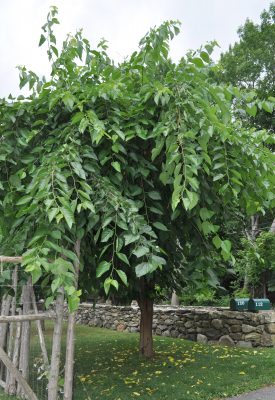
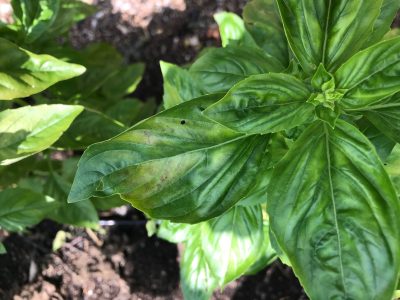
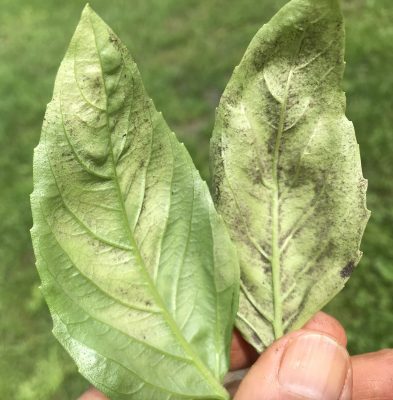
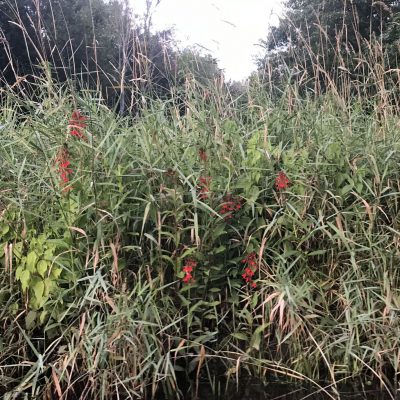 More than I have ever seen in the wild. (In Chanticleer Garden outside Philadelphia is a wet meadow planted thickly with cardinal flowers.)
More than I have ever seen in the wild. (In Chanticleer Garden outside Philadelphia is a wet meadow planted thickly with cardinal flowers.)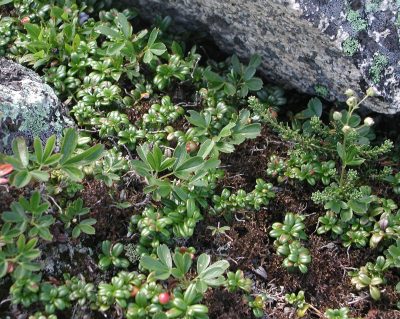
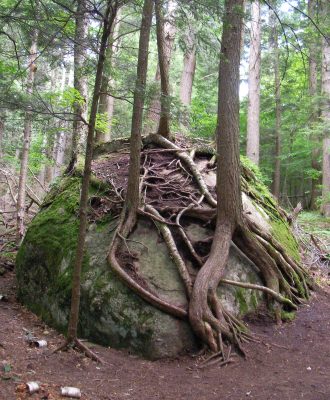
 (Compost is all my vegetables get.) And perhaps focussing more on what food really tastes like. Does Sugarbuns supersweet really taste like corn. Or a candy bar?
(Compost is all my vegetables get.) And perhaps focussing more on what food really tastes like. Does Sugarbuns supersweet really taste like corn. Or a candy bar?